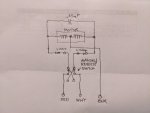I have a 12 year old pentair actuator (CVA-24T) on my suction side that controls if the water is coming from the pool or the spa. Recently the actuator has not been alternating moving back and forth like it is supposed to. What I mean by that is the pool is running and I'll turn the spa on, it will rotate from one side to the other and stop. Then when I switch back from spa to pool mode, instead of rotating back, it will keep rotating the same way and turn the valve to block all water from the pump! Sometimes it rotates back and forth like it's supposed to and other times it keeps rotating the same way and goes around blocking the pump to the other side. It almost seems random which way it chooses.
The first thing I did was replace the 2 micro switches on the inside and make sure the cams were tight. That didn't seem to make a difference.
Does anyone know what causes the actuator to know to switch directions when the control board switches from pool to spa or vice versa? I'm trying to avoid having to spend $150 on a brand new actuator and I'm not even sure that will fix the issue. Thank you.
The first thing I did was replace the 2 micro switches on the inside and make sure the cams were tight. That didn't seem to make a difference.
Does anyone know what causes the actuator to know to switch directions when the control board switches from pool to spa or vice versa? I'm trying to avoid having to spend $150 on a brand new actuator and I'm not even sure that will fix the issue. Thank you.


